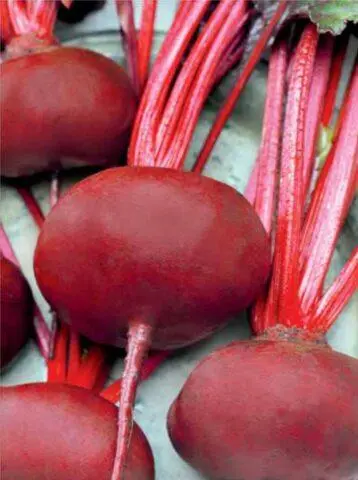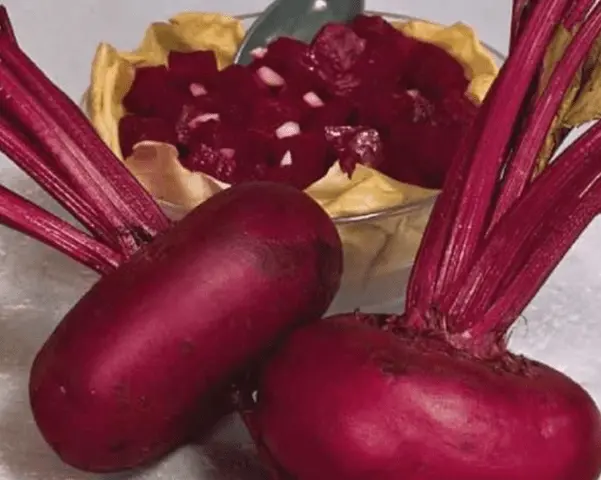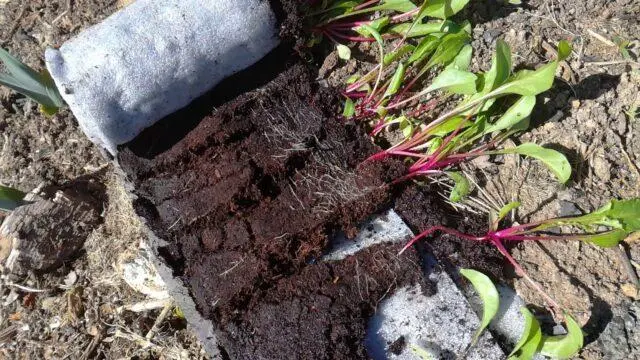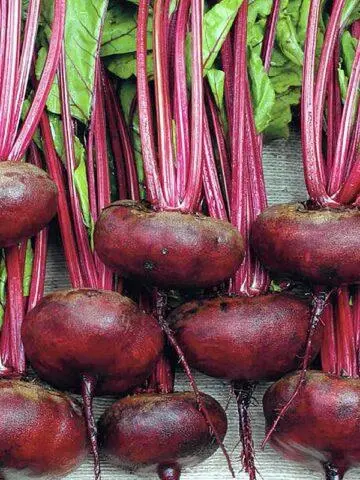Contents
Egyptian flat beet is a variety known for over 80 years. Due to its resistance to frost, drought and pests, it is recommended for cultivation in almost all regions. The yield is high and reaches 7-8 kg per square meter. At the same time, root crops are perfectly stored in the winter and can be used for any purpose.
History of origin
The Egyptian flat beet variety was bred in 1937 on the basis of the Voronezh Agricultural Scientific Center named after V.V. Dokuchaev. Passed successful tests and included in the register of breeding achievements in 1943. Recommended for cultivation in most regions:
- middle lane;
- Chernozem region;
- the Volga region;
- The Urals;
- Eastern Siberia;
- Far East.
For several decades, Egyptian flat beets have been grown both in Our Country and in neighboring countries, including Ukraine, Armenia, Tajikistan and Kyrgyzstan. Recommended for use in the autumn-winter period.
Description of the beet variety Egyptian flat
The plant is an upright shrub with rosettes of leaves growing up to 45–50 cm in height. Petioles reach 25 cm, up to 1,2 cm in diameter. The color is pink-red, which indicates a high content of anthocyanins. At the same time, as it grows, the color becomes more intense, reaching a maximum degree of saturation by the end of the season.
The leaves of the Egyptian flat beet are painted in dark green. Medium size – up to 22 cm long, up to 14 cm wide. The shape is elongated, the edges are wavy. The surface of the plate has a slight sheen, moderately bubbly. The lateral veins and the central vein are reddish-purple.
The roots of Egyptian flat beet are strongly flattened on the sides, their shape is flat-round, which is why the variety got its name. The head is small, the axial root is long, of moderate thickness. The beetroot reaches 6,5–12,5 cm in diameter, up to 8 cm in height. On average, the mass is from 200 to 300 g, individual specimens up to 500–520 g. The color is typical dark red, the surface is smooth.

Beet roots of this variety have a flattened shape
The pulp is moderate tenderness, juicy, moderately dense. Intense pink to red color, slightly purple. The rings are visible, but not too pronounced, without streaks of white. Taste qualities are very good, moderately sweetish tones are noticeable.
Characteristics of beetroot Egyptian flat
Egyptian flat beet refers to mid-season varieties – from the emergence of seedlings to full ripening, 100–120 days pass, i.e. no more than 4 months. The maturation period of the Egyptian flat beet falls at the end of June – the beginning of July (when planting seedlings in the first decade of March). However, they may change slightly due to weather conditions, but the fluctuations are small.
The variety is quite productive – from 1 m2 collect 5–8,3 kg of root crops. At the same time, during the growing season, the roots are immersed in the soil by about half or a little more. The Egyptian flat tree tolerates short-term cold snaps and droughts well. Therefore, the variety is successfully grown in different regions of Our Country.
Egyptian flat beets are not prone to flowering (i.e., they almost always give root crops, and do not go into color), which explains the high yield. At the same time, the fruits are durable and transportable, they can be transported for sale or processing even over long distances. Under the right conditions, it is well preserved throughout the autumn and winter (the degree of preservation is from 75% to 89% of root crops).
Advantages and disadvantages
Egyptian beetroot has a good taste and high yield. At the same time, the variety is not demanding on growing conditions, it normally tolerates frost and drought. Therefore, it has spread both in Our Country and in a number of neighboring countries.

The yield of the Egyptian flat variety reaches 8 kg per 1 m2
Pros:
- pleasant taste;
- attractive presentation;
- keeping quality and transportability;
- resistance to diseases, frost and drought;
- high yield;
- unpretentiousness, can be grown in different regions.
Cons:
- not resistant to cercosporosis;
- seeds germinate for a long time;
- in some cases, germination is low.
How to plant Egyptian flat beetroot
Sowing beets Egyptian flat is possible in two ways – through seedlings or direct planting of seeds in the ground. In this case, landing can be carried out both in spring and before winter. The timing depends on the method of cultivation, as well as on the climatic features of the region:
- For seedlings – from early March to mid-April, planning a transplant into the ground or into a greenhouse a month after germination.
- In open ground – from late April to mid-May, when the soil warms up to at least 6 degrees Celsius.
- Podzimny sowing – from the second half of October to early November. In this case, only dry seeds of the Egyptian flat beet can be sown.
Seedling method of growing
In reviews of Egyptian flat beets, summer residents often write that seeds do not germinate well. In most cases, this is due to poor-quality selection and preparation of seed. A few days before landing, you must perform the following actions:
- Determine germination by immersing the seeds in a salt solution and waiting 5 minutes. If any come up, they are discarded.
- Immerse the Egyptian flat beet seeds in warm water and hold for several hours until completely swollen.
- Put the glass in the bottom of the refrigerator and hold for a week.
After completing the preparation, you can start landing. You need to grow them according to the following instructions:
- Make up a mixture of soddy soil with black peat, humus and sand (2: 1: 1: 1).
- Packed in boxes or containers.
- Sow the seeds to a depth of 1,5-2 cm with an interval of 3-4 cm.
- Watered, covered with glass and grown at a temperature of 18-20 degrees.
- Shoots appear for quite a long time – after 15-20 days, which is normal. After that, it is better to lower the temperature to 15 degrees.

Seedlings can be grown with or without a dive
Landing in open ground
Planting Egyptian flat beets in open ground is carried out according to the following scheme:
- depth 2–3 cm;
- furrows at a distance of 15–20 cm;
- the distance between adjacent seeds is 6–7 cm.
Thinning is carried out after the seedlings grow to 10 cm. If there is space, the “extra” seedlings are transferred to the next bed.
Beet Care Egyptian Flat
Caring for this variety is quite simple. It is necessary to ensure watering – it should be regular, but not excessive. Water is given only at the moment when the surface layer of the soil has dried up. A few days after each watering, loosening is carried out, if necessary, weeding.
Egyptian flat beet is responsive to fertilizers. The first (complex mineral or nitrogen) is introduced at the seedling stage, after the appearance of the second pair of leaves. In open ground, fertilize twice at the stage of root formation with a break of 2-3 weeks. Superphosphate is used for top dressing (40 g per 1 m2) and potassium salt (25–30 g per 1 m2).

To get a good harvest, beets need to be fed twice a season.
Possible diseases and pests
The variety has good resistance to most diseases and pests. But Egyptian flat beets, under conditions of improper care, can suffer from diseases such as phomosis (phoma rot) and cercosporosis. For prevention, it is necessary to lime the soil (if it is acidified), and at the first symptoms, treat it with a fungicide:
- “Acanto Plus”;
- “Rias””;
- “Benorad”;
- “Sphere Max”;
- “Falcon”;
- “Scalpel” and others.
Also, Egyptian flat beets can be affected by bears, bugs, aphids, flies and other pests. As a preventive measure, it is recommended:
- comply with the watering rate;
- loosen the soil;
- do weeding;
- remove damaged parts of the tops.
For treatment, folk remedies are used (an infusion of tobacco dust, a decoction of the tops of tomatoes, potatoes, an infusion of wood ash) and insecticides:
- “Medvetoks”;
- “Biotlin”;
- “Aktara”;
- “Confidor”;
- “Inta-Vir” and others.
Conclusion
Egyptian flat beet is a long-known variety that is resistant to adverse weather conditions, pests and diseases. Root crops are tasty, they are universal vegetables. Used fresh, in various dishes and winter preparations.










